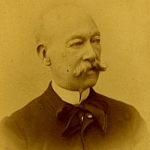
FAMOUS IN MAASTRICHT
Here is a list of famous Maastricht people.
We didn't include high visitors like Charlemagne, Charles the Fifth and other emperors,
kings, popes and presidents. Nor present-day footballers, television personalities and prominents who may
soon be forgotten.
The famous musketeer d'Artagnan died in Maastricht, and the wellknown biologist Jacques Thijsse was born there, but they
can't be counted as Maastricht inhabitants. Prime Minister Ruys de Beerenbrouck can't, either.
We chose twentyfive people who mostly occur in the names of Maastricht streets and institutions. We tried to choose
people from as many distinct fields of public interest as possible.
Therefore, we didn't choose Joseph Hollman together with Batta, etc. For similar reasons, we didn't add, for example,
baron Aylva, doctor Bak, paleontologist Dubois, bishop Hubertus, Edmond Jaspar, father Roothaan,
governor Tilly, Aert van Tricht and master Ulrich.
We admit our choice is rather arbitrary. Yet we think the ten most famous Maastricht people must be among our twentyfive.
Here "famous" means: famous in Maastricht.
Batta, Alexander
Maastricht 1816 - Versailles 1902. Violon cellist and componist.
He first studied with his father, who was a cellist and a teacher of singing, and then at the conservatory in Brussels.
Finally, he settled in Paris.
His two brothers were gifted musicians as well. In 1829 and 1830, the musical family gave joint performances in Maastricht.
Alexander gathered a lot of distinguishing marks, appeared before diverse kings, and was called Chopin of the
violon cello. In 1892, ten years before his death, Maastricht already named a new boulevard after him.
After his decease, he left a fund for young violists and cellists in his birth town.

Debye, Peter
Maastricht 1884 - Ithaca (USA) 1966. Fysical chemist.
After his school period in Maastricht, Peter went to Aachen, to study mathematics, physics and electrical engineering.
For his research in the field of molecule structure, he received the 1936 Nobel prize for chemistry.
Debye became director of the Max Planck Institute in Berlin, succeeding Albert Einstein. When the nazis took over the
Institute, our hero departed for America.
He was married, and had a son and a daughter.
The son became a physicist as well.
Near the Academical Hospital in Maastricht, an avenue and a square bear the name of Peter Debye.

Dibbets, Bernard
Arnhem 1782 - Maastricht 1839. General.
From the Belgian revolt in 1830 until the definite separation of Belgium in 1839, general Dibbets and his garrison
preserved the fortified city of Maastricht for the Netherlands. Dibbets often had to act strictly. For instance, he
took strong action against a group of
'seditious' from the region who tried to smuggle the town into the hands of Belgium by 'hatching attack plots in the dark'.
He also expelled a recalcitrant chaplain, who subsequently strode out of the town in full pontificals.
The Maastricht people hated Dibbets at the time, but nowadays they are mostly grateful for his steadfastness.
General Dibbets lived in the generaalshuis (theatre at Vrijthof square).

van Eyck, Jan
Maaseik circa 1390 - Brugge 1441. Painter.
Jan van Eyck was a master in painting perspective and light. As a portraitist he was razor sharp. Jan and his elder
brother Hubert learnt the art of painting in Liège and Maastricht. Their joint masterpiece is the Lamb of God.
During the 1408 siege of Maastricht, both brothers were in Maastricht among the people around the Liège prince-bishop
John of Bavaria.
Later on, Jan van Eyck was also a friend of the Burgundian duke Philip the Good, who was godfather of a child of the painter,
and for whom he proposed to the infante Isabella of Portugal.
In Maastricht we have the Jan van Eyck Academy for arts of design since 1948.
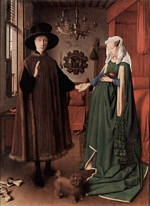
Franquinet, Guillaume Désiré Lambert
Maastricht 1826 - 1900. Lawyer, etc.
After his childhood in Maastricht, he studied law in Brussel. He settled in his birth town as a lawyer in 1849.
Then he began a many-sided life: he was a linguist, and wrote comical plays in dialect.
He was secretary of the civil administration for the poor, and school inspector. He studied plants and flowers, and was also a
miller. He was a member of the city council, and an alderman. Together with Alphonse Olterdissen, he organised
historical parades as a member of the Momus Society. He was co-founder of the Limburg Association for History and Antiquity.
He was an archivist for both the town and the province.
Shortly after his death, Maastricht named a street after him in the new city district Brusselsepoort.
His son Edmond was the proud owner of a motor car.
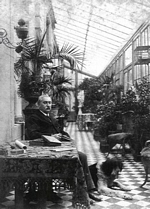
Herbenus, Mattheus
Maastricht 1451 - 1538. Humanist, etc.
Mattheus Herben was a canon of Saint John's fraternity and a chaplain of the chapter of Saint Servatius.
He was a teacher of the chapter school, and one of the first Dutch humanists. He was a musician and a poet as well.
His book "De Trajecto Instaurato" (About Restored Maastricht) is one of the eldest descriptions of a town in the Netherlands.
He also wrote about the devastation of Liège by Charles the Temerary in 1467.
In 1880, Regout junior had workers' dwellings built along the new Herbenus Avenue at the place of the demolished city walls.

Hermans, Henri
Nuth 1883 - Maastricht 1947. Musician.
Father Hermans was the first to teach Henri playing music. Only fifteen years old, he became organist in the village church
of Nuth.
However, when our young hero was appointed organist and choral conductor of Our Lady's Church in 1902, he left
the parental dwelling and settled in Maastricht. He studied further in Liège and Köln, and, meanwhile, became
teacher at the music school and conductor of the orchestra in Maastricht. He lifted both institutions up to a professional
level. Thus, the Maastricht City Orchestra was to develop and become the Limburg Symphony Orchestra.
It is only fair the Henri Hermans park with the birdcage bears his name.

Jonas, Henri Charles
Maastricht 1878 - 1944. Artist.
Henri was first a house painter, like his father. When both his wife and his father died within one year, he
went to Amsterdam and studied art. Then he settled in Maastricht again, where his talent began flourishing.
He also painted beautiful leaded windows (for example in the Koepelkerk).
He wished to marry a divorced woman he made acquaintance with in Paris, but his ecclesiastical principals didn't allow that.
This brought him into a depression from which he never recovered. He ended up in psychiatrical clinics,
first in Venray and then in Maastricht in Mount Calvary. There he still made important pieces of art.
In the city district Caberg, a street bears his name.

Kemp, Petrus Johannes
Maastricht, 1886 - 1967. Poet.
As a young man, Pierre Kemp was a meritorious painter (of ceramic art). His brother Mathias was a poet and painter too.
Only when he was nearly fifty, Pierre began to write poetry.
He worked with the wages administration of coal mine Laura. In the train to and fro Maastricht, dressed in a black suit,
he wrote numerous light and colourful poems.
Anywhere roaming, sketching flowers on the twigs before they are there:
prating poem fragment showers, old-man-desperate and toddler-bare.
Pierre Kemp received important literary prizes.
In the city parc (Kempland), a monument has been erected for him.
van Kleef, Lambertus Theodorus
The Hague 1846 - 1928. Physician-director.
First he was a health officer with the Red Cross. Prussia knighted him for his work during the war between France and
Germany.
After 1880, he became a surgeon in the Maastricht hospital Mount Calvary. He made the hospital
a more modern institution, by performing experiments with röntgen rays and stomach operations, and strict
application of hygiene.
From 1897 till 1904, he was physician-director.
Then he returned to the Hague, as a pensioner. But he requested they would
bury him in Maastricht. This request was complied with.
Maastricht named a street after him in the district Brusselsepoort.

Lambert, Saint
Maastricht 638 - Liège 706. Bishop.
Lambert was the last but one in a sequence of twentyfive Maastricht bishops. People in Maastricht know the exact place
of his birth and the place of his first grave. Legend says Lambert rebuked the Frankish major-domo Pepin of Heristal for
conjugal infidelity and that's why he was murdered. Anyhow, he was involved in a lot of political questions. His successor
Hubert moved the episcopal see and the bones of Lambert to the Frankish residence of Pepin where Lambert was murdered.
There the town of Liëge originated next the grave of the holy martyr.
In Maastricht, an avenue in the Villapark and a een monumental church bear the name of Lambert. In Liège, the
central square is called Place Saint Lambert.
Minckeleers, Jan Pieter
Maastricht 1748 - 1824. Scientist.
This Jesuit was since 1771 a professor of Science at the university of Louvain. He discovered how to use
coal gas for gas lamps and air balloons. In 1789 he had to return to his birth city for political reasons. He settled there
as a pharmaceutical chemist. He was also interested in meteorology, geology and paleontology. And he made a description
of the fossil Mosasaurus that had been found in the Sint-Pietersberg marl.
In Maastricht, his statue with an eternal flame from a gas pipe is standing at the Market side of the Boschstraat
since 1904. Furthermore, a street in the city center bears his name. In Louvain-Heverlee, there's another statue of him.
Olterdissen, Alphonse
Maastricht 1865 - 1923 . Artist.
Olterdissen's father came from Hannover in Prussia, his mother from Veere in Zeeland. They married in the Lutheran church,
and began a small tobacco shop in the Boschstraat (now nr 107). When Alphonse was eight years old, his father died.
Olterdissen studied art in Amsterdam.
Back in Maastricht, he founded a school for artists.
He was co-founder of "Maastricht Ahead", and a member of the Momus Society. He wrote some musicals in Maastrichts dialect
to pay off the debts he made while organizing four parades. The final song of "Trijn de Begijn" became the
Maastricht city hymn.
Alphonse was a city councillor, a school inspector and a writer about Maastricht
history. In 1921, he became Catholic. His statue is in the Grote Looiersstraat. See also a story by Fons Olterdissen
Regout, Petrus Dominicus Laurentius
Maastricht 1801 – Meerssen 1878. Big Industrialist.
Petrus Regout continued his mother's glass and earthenware shop. After the Belgian Revolt, Maastricht came into an
economical isolation. But Regout didn't give up. He developed in a short time a glass and earthenware factory at the
Boschstraat. It was the first large scale industry in the Netherlands.
In 1851, he bought Vaeshartelt Castle, which he transformed into a pleasure ground. King Willem I came often to stay there.
Regout had a villa built for each of his ten children. For his workers, he built the infamous Cité Ouvrière,
near the factory. The workers considered him a father, but found the son who succeeded him hardhearted. The statue of
Pierre Regout is standing before the entrance of the factory.

Rieu, André
Maastricht 1949 - ... Popular violinist and orchestra leader.
André Rieu grew up in a musical family. His father was a conductor. André studied violin in Liège,
Maastricht and Brussels. He wanted to make classical music accessible to everybody. Therefore he first set up the
Maastricht Salon orchestra, and later on the Johann Strauss orchestra. Nowadays, he's playing to a full house everywhere
in the world.
Of course, his story is not yet finished. So we make it short.
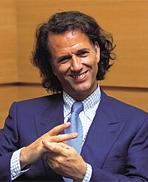
Romanus, Franciscus
Ghent 1647 - Paris 1735. Architect.
The Dominican lay brother Franciscus Roman renewed the first arc at the Maastricht side of the old bridge across river Maas.
He also restored the fourteenth century Dominican monastery which was closed in the French era, but served as a Civil High
School until late in the twentieth century. In 1685, Franciscus Romanus was summoned to Paris by the advisers of king
Louis the Fourteenth to restore the Pont Royal and the Pont Neuf.
Around 1990, the houses against the Dominican wall
(a part of the first city wall)
were destructed to make more room for the Theatre at Vrijthof Square.
The photo below shows the Dominican Church, which is now
a bookshop. The Franciscus Romanus road runs at the Eastern side along river Maas.

Rutten, mgr Louis Hubert
Maastricht 1809 - 1891. Priest.
Louis Rutten was the son of a brewer in easy circumstances. He was ordained a priest and wished to become a missionary, but his
health was too weak. Therefore, he began to teach the workers' children in a hall of Saint Servatius Church. He also gave them
food and clothes. In the evening, he would teach the adult workers.
In 1840, he founded the congregation of the brothers of Maastricht, who took up the education of the boys. Meanwhile, the
sisters Ursulines did the education of the girls. Mgr Rutten invited the Sisters of Charity to come to Maastricht
and lead a home for unmarried mothers.
After 1860, his health was so bad that life became a burden for him. But he persevered during another thirty years.
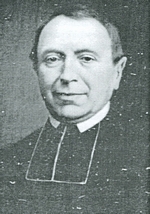
Servatius, Saint
Armenia after 300 - Maastricht 384. Bishop.
Saint Servatius was bishop of Tongeren. He advocated Jesus' divinity against arianism at two important Church synods.
Finally, he fled with the episcopal see to Maastricht, and, thus, he became the first wellknown faith preacher within the present
boundaries of the Netherlands.
After his death, many legends arose around person and work of Saint Servatius. His grave became a pilgrim's resort
where a large church gradually developed. Emperors and kings came to pray there. Henric van Veldeke wrote a
biography. Maastricht history is closely related to the history of Saint Servatius' Basilica.
The old bridge across river
Maas bears his name, too.

van Steffenswert, Jan
Maastricht circa 1470 - 1525. Woodcarver.
Jan van Steffenswert knew how to create beautiful threedimensional compositions from a simple block of wood.
The sculptures with his mark can be found in churches and musea all over the world.
Since 1990, we know from sources in the archives that he worked and lived in Maastricht.
His workshop probably was in the Mariastraat.
The sculpture of Saint Christopher (photo) stands in Our Lady's basilica in Maastricht, close by the entrance, so it's easy
to go and greet it every day. According to tradition, nothing can harm you that day.

Strouven, Elisabeth
Maastricht 1600 - 1661. Pious woman.
Elisabeth was a shoemaker's daughter with a good education.
She was a needlewoman and boarding school proprietress. Meanwhile, she did spiritual exercises under the guidance
of Jesuits and Franciscans. She wandered about with an epileptic girl.
People thought the girl was possessed by the devil.
At Good Friday 1628, Elisabeth founded the convent Mount Calvary, which was to become the wellknown nursing
home. She nursed pestilence patients.
After the Dutch conquered the city from the Spaniards in 1632, Catholic life became very difficult in Maastricht.
Elisabeth's confessor Vinck was beheaded. She herself wrote a detailed autobiography.

de Stuers, jonkheer Victor Eugène Louis
Maastricht 1843 - the Hague 1916. Protector of art, top functionary and politician.
Thanks to the wilfulness of Victor de Stuers, we still have a large part of the Maastricht city walls.
He is considered the most important pioneer of the Dutch care for Monuments. He was also closely involved in the construction
of the Amsterdam Rijksmuseum.
De Stuers, who lived in the Hague since 1870, was first a lawyer. Later on, he became referendary of the Department of the
Interior. He was in charge of, among other things, the care for monuments, musea and archives. In the Second Chamber, too,
his obstinate character struck everybody.
De Stuers married when he was 49, and got a daughter.
He was buried in Maastricht. A street in in the city district Brusselsepoort bears his name.

Tapijn, Sebastiaan
.... - Maastricht 1579. Garrison commander.
After troubles with the Spanish garrison that had its quarters in the city since the 1566 iconoclasm, Maastricht decided to
admit a Protestant garrison. The duke of Parma (photo) came to besiege the fortified town.
Sebastien Tafin defended Maastricht in an exceptionally brave and stubborn way, but eventually got the worst of it.
After the surrender, the furious Spaniards executed the commander. They plundered Maastricht and killed thousands of citizens.
This disaster is known as the 1579 Spanish fury. Three years earlier, there had already been a similar disaster on a
smaller scale.
Nowadays, the Tapijn barracks in the city parc bear Tafin's name.

van Veldeke, Henric
Born before 1150 at Veldeke near Maastricht or between Hasselt and Diest - deceased before 1210. Poet.
Veldeke was a noble, and employed by countess Agnes van Loon. He became a many-sided and influential poet
both in Middle Dutch and Middle High German. His work has a post-Carolingian character.
He wrote, among other things, thirty love songs and the Legend of Saint Servatius:
... All daer hij noch is, te Triecht, In eynen dall scoen ende liecht ... - ... He is still there in Maastricht, in a valley
full of light and beauty ...
His statue is standing between the churches of Saint John and Saint Servatius at Henric van Veldeke square.
In Hasselt, too, there's a statue of Veldeke.
Furthermore, we have the Veldeke college and the Veldeke circle for
students of dialect.
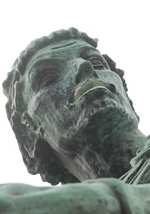
Vinck, Servatius
... - Maastricht 1638. Franciscan.
Father Vinck was a kind-hearted Franciscan friar and a good preacher. The Maastricht people loved him. However, he was
a bit too naive.
In 1632, Frederik Hendrik conquered the fortified city of Maastricht from the Spaniards.
The Dutch now made Catholic life in the town almost impossible. In 1638, they cut off the heads of five "traitors" who
wished to smuggle the city into the hands of the Spaniards again. Father Vinck was one of them.
Their heads were exhibited on the round bastion which nowadays bears the name "the five heads", near the little tower
of father Vinck. Vinck's portrait (below) is hanging in the treasure room of Our Lady's basilica. The only thing we can
"reproach" him with, is that he didn't tell the Dutch what his fellow beheaded had said to him in the confessional box.

Vliegen, Willem
Gulpen 1862 - Bloemendaal 1947. Journalist and politician.
As a young man, Vliegen was a typographer in Maastricht, and editor of the Volkstribuun. He admired Ferdinand Domela
Nieuwenhuis, whom the workers used to call "our Redemptor". However, Vliegen was much more practical. He was one of the
founders of the Socialist party SDAP, and became a parliamentarian, party president, and alderman of Amsterdam.
He didn't support Troelstra's revolution, either.
Willem Vliegen was a self-taught man. He developed from
a simple worker to an eloquent parliamentarian.
His bust stands on the Brandenburger square in the Maastricht city district Blauwdorp.

LITERATURE (mainly Dutch): Maastrichtse straatnamen tot 1 jan. 1997; Bert Lejeune, Bisschopsmolen. Furthermore, Wikipedia and many other
sources on the Internet.